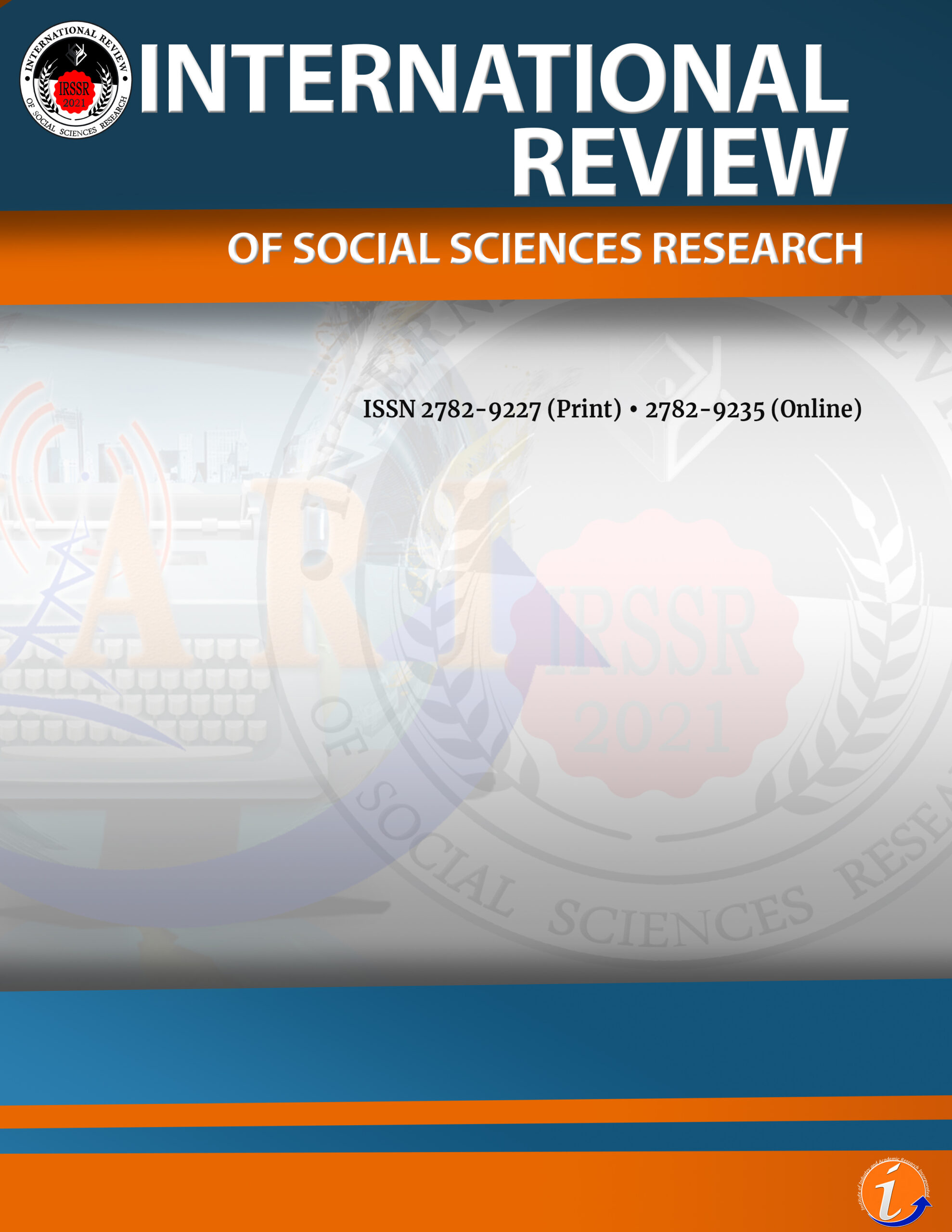This study aims to evaluate how great power competition in the Arctic, driven by new maritime routes emerging from melting sea ice due to climate change, significantly reduces shipping distances between Europe and Asia and impacts the dynamics of the Indo-Pacific region. This development has intensified strategic competition among major powers, especially China, the United States, and Russia. According to the realism theory, these countries pursue national interests by seeking to establish influence over the Arctic route. This study uses a qualitative methodology based on a comprehensive literature review, analyzing secondary data from academic publications, policy documents, and expert reports. The findings are synthesized and presented through descriptive narrative analysis to provide insights into the complex interactions between Arctic developments and Indo-Pacific regional dynamics. This study reveals that great power competition centered on the Arctic has substantial spillover impacts in the Indo-Pacific region, especially on regional environmental sustainability and geopolitical stability, particularly in the Malacca Strait region. A major limitation of this study lies in the evolving nature of great power competition in the Pacific Ocean, which poses challenges in accessing up-to-date information and analyzing fast-changing dynamics. The study concludes that the interconnectedness between the Arctic and the Indo-Pacific requires a nuanced understanding of the evolving geopolitical landscape. The findings have implications for regional security, economic cooperation, and environmental sustainability in both regions.
Arctic, climate change, great power competition, Indo-Pacific
Maria Chris Lievonne. Corresponding author. A magister student of the Defense Strategy Faculty majoring in Total War Strategy of the Republic Indonesia Defense Strategy (RIDU). Email: mlievonne@gmail.com
Fauzia Gustarina Cempaka Timur. Doctorate degree from International Relations and Affairs Universitas Padjadjaran. She is an assistant professor in the Defense Strategy Faculty of the Republic Indonesia Defense University (RIDU).
Almuchalif Suryo. Doctorate in defense science and lecturer in the Defense Strategy Faculty of the Republic Indonesia Defense University (RIDU).
“All authors equally contributed to the conception, design, preparation, data gathering and analysis, and writing of the manuscript. All authors read and approved the final manuscript.”
No potential conflict of interest was reported by the author(s).
This work was not supported by any funding.
Not Applicable.
The author declares the use of Artificial Intelligence (AI) in writing this paper. In particular, the author used Scopus AI and Gemini 1.5 Flash to generate information for background research. The author takes full responsibility in ensuring proper review and editing of contents generated using AI.
Ahmed, Z. (2022). Great power rivalry in Indo Pacific: Implications for Pakistan. Strategic Studies, 41(4), 56–75. https://doi.org/10.53532/ss.041.04.0037
Bekkers, F., Bolder, P., Chavannes, E., Oosterveld, W., de Wijk, R., & Braun, J. F. (2019). Geopolitical trends and developments. In: Geopolitics and Maritime Security: A broad perspective on the future capability portfolio of the Royal Netherlands Navy. http://www.jstor.org/stable/resrep19561.5
Bidgood, S. (2023). What we talk about when we talk about US-Russia strategic stability. Journal for Peace and Nuclear Disarmament, 6(1), 9–27. https://doi.org/10.1080/25751654.2023.2221486
Biedermann, R. (2022). Exploring Sino-Russian-Nordics triangular relations: complex balancing along the Polar Silk Road. Journal of Contemporary European Studies, 30(4), 623–639. https://doi.org/10.1080/14782804.2021.1924640
Blinken, A. J. (2021). A free and open Indo-Pacific. https://www.state.gov/a-free-and-open-indo-pacific/#:~:text=At%20President%20Biden’s%20direction%2C%20we,including%20around%20trade%20and%20the
Bossuyt, F., & Kaczmarski, M. (2021). Russia and China between cooperation and competition at the regional and global level. Introduction. Eurasian Geography and Economics, 62(5–6), 539–556. https://doi.org/10.1080/15387216.2021.2023363
Brauch, H. G. (2021). Peace ecology in the Anthropocene. In Ú. Oswald Spring & H. G. Brauch (Eds.), Decolonising Conflicts, Security, Peace, Gender, Environment and Development in the Anthropocene (pp. 51–185). Springer International Publishing. https://doi.org/10.1007/978-3-030-62316-6_2
Bungin, B. (2022). Post-Qualitative: Social Research Methods (Ketiga). Kencana.
Burchill, S., Linklater, A., Donnelly, J., Nardin, T., Paterson, M., Reus-Smit, C., Saramago, A., Haastrup, T., & Sajed, A. (2022). Theories of international relations. Bloomsbury Publishing.
Chang, Y.-C., & Khan, M. I. (2021). May China Fish in the Arctic Ocean? Sustainability, 13(21), 11875. https://doi.org/10.3390/su132111875
Chen, L. (2021). Russia’s Eastward policy during Putin’s era. Tamkang Journal of International Affairs, 25(1), 311–330.
Christie, E. H., Buts, C., & Du Bois, C. (2023). Demand for military expenditures and security alignment choices in the Indo-Pacific. Defence and Peace Economics, 34(5), 581–602. https://doi.org/10.1080/10242694.2022.2073430
Conley, H. A., Melino, M., Tsafos, N., & Williams, I. (2020). Near-peer competitor military posture in the Arctic to 2050: Three scenarios. in America’s Arctic moment: Great power competition in the Arctic to 2050. http://www.jstor.org/stable/resrep24235.6.
Constable, A. J., Harper, S., Dawson, J., Holsman, K., Mustonen, T., Piepenburg, D., & Rost, B. (2022). Polar Regions. In H.-O. Pörtner, D. C. Roberts, M. Rignor, E. S. Poloczanska, K. Mintenbeck, A. Alegria, M. Craig, S. Langsdorf, S. Löschke, V. Möller, A. Okem, & B. Rama (Eds.), Climate change 2022 – Impacts, adaptation and vulnerability (pp. 2319–2368). Cambridge University Press. https://doi.org/10.1017/9781009325844.023
Contributeurs de Baripedia. (2024). Classical Realism and Its Implications in Modern Geopolitics. In Baripedia (Ed.), Contributeurs de Baripedia. https://baripedia.org/index.php?title=Classical_Realism_and_Its_Implications_in_Modern_Geopolitics&oldid=66470.
De Castro, R. C. (2019). The role of middle powers in the modernization of the armed forces of the Philippines (AFP): The case of the special Japan–Australia strategic partnership and the Philippines. Korean Journal of Defense Analysis, 31(1), 145–164.
Dezhina, I., & Wood, E. A. (2022). US-Russian partnerships in science: working with differences. Post-Soviet Affairs, 38(5), 349–365. https://doi.org/10.1080/1060586X.2022.2035630
Dikarev, A., & Lukin, A. (2021). The PRC’s approach towards the South China Sea territorial dispute and Russia’s foreign policy. World Economy and International Relations, 65(2), 5–15. https://doi.org/10.20542/0131-2227-2021-65-2-5-15
Enfu, C., & Jing, L. (2024, July 1). Changes in U.S. grand strategy in the Indo-Pacific and China’s countermeasures. Monthly Review. https://monthlyreview.org/2024/07/01/changes-in-u-s-grand-strategy-in-the-indo-pacific-and-chinas-countermeasures/#:~:text=With%20the%20gradual%20advance%20of,become%20increasingly%20fierce%2C%20particularly%20the
Enodo Global. (2018). Social risk analysis: Malacca Straits. https://enodoglobal.com/wp-content/uploads/2019/01/ENODO_Social-Risk-Analysis_Strait-of-Malacca_20180509_FINAL-copy.pdf
Fravel, M. T., Lavelle, K., & Odgaard, L. (2022). China engages the Arctic: a great power in a regime complex. Asian Security, 18(2), 138–158. https://doi.org/10.1080/14799855.2021.1986008
Gao, T., & Erokhin, V. (2020). China-Russia collaboration in arctic shipping and maritime engineering. The Polar Journal, 10(2), 353–374. https://doi.org/10.1080/2154896X.2020.1799612
Gaskarth, J. (2022). Strategy, tactics and tilts. The RUSI Journal, 167(6–7), 12–23. https://doi.org/10.1080/03071847.2022.2159515
Greco, A. (2022, February 17). The Strait of Malacca: From Sultanates to Singapore. CIMSEC. https://cimsec.org/the-strait-of-malacca-from-sultanates-to-singapore/
Heng, C., & Freymann, E. (2023, July). Outsiders wanting in: Asian States and Arctic Governance. Arctic Initiative.
Johansen, E. (2018). Climate change and the Arctic: Legal regulations in changing times. In The Marine Environment and United Nations Sustainable Development Goal 14 (pp. 368–390). Brill Nijhoff. https://doi.org/10.1163/9789004366619_024
Koziej, S. (2020, May 5). The U.S. and China: The rivalry escalates. GIS. https://www.gisreportsonline.com/r/us-china-rivalry/
Krasnozhenova, E. E., Kulik, S. V, Chistalyova, T., Yu Eidemiller, K., & Karabushenko, P. L. (2021). How do Southeast Asian countries participate in the development of the Arctic. IOP Conference Series: Earth and Environmental Science, 625(1), 012009. https://doi.org/10.1088/1755-1315/625/1/012009
Lanteigne, M. (2021). Not being absent: Chinas Polar Silk Road and the politics of identity. In Research Handbook on the Belt and Road Initiative. Edward Elgar Publishing. https://doi.org/10.4337/9781789908718.00045
Lavengood, Z. (2021). The Evolving Arctic in the World-System. Journal of World-Systems Research, 27(2), 468–493. https://doi.org/10.5195/jwsr.2021.1042
Li, J. (2017). Developing China’s Indian Ocean Strategy: Rationale and Prospects. China Quarterly of International Strategic Studies, 03(04), 481–497. https://doi.org/10.1142/S2377740017500270
Li, J., Liu, H., Zhang, W., & Huang, Q. (2023). Spatio-temporal characteristics of global maritime ship casualties. Journal of Physics: Conference Series, 2486(1), 012021. https://doi.org/10.1088/1742-6596/2486/1/012021
Li, X.-M., Qiu, Y., Wang, Y., Huang, B., Lu, H., Chu, M., Fu, H., & Hui, F. (2022). Light from space illuminating the polar silk road. International Journal of Digital Earth, 15(1), 2028–2046. https://doi.org/10.1080/17538947.2022.2139865
Lukin, A. (2021). The Russia-US-China Strategic Triangle in the Asia-Pacific. In Contributions to International Relations (pp. 99–120). https://doi.org/10.1007/978-3-030-75925-4_5
Mahan, A. T. (1890). The Influence of sea power upon history, 1660-1783. Boston: Little, Brown and Company. https://archive.org/details/seanpowerinf00maha/page/n5/mode/2up
Marusin, A., Shiapov, T., Petrov, A., Talanova, I., & Alexeevsky, M. (2022). Transport infrastructure of the Arctic Zone: The calm before the breakthrough? 2022 International Conference on Engineering Management of Communication and Technology (EMCTECH), 1–5. https://doi.org/10.1109/EMCTECH55220.2022.9934052
McCarthy, N. (2020, November 16). 15 countries sign world’s biggest free trade deal. Statista. https://www.statista.com/chart/23497/key-facts-about-the-regional-comprehensive-economic-partnership/
Meredith, M., Sommerkorn, M., Cassotta, S., Derksen, C., Ekaykin, A., Hollowed, A., Kofinas, G., Mackintosh, A., Melbourne-Thomas, J., Muelbert, M. M. C., Ottersen, G., Pritchard, H., & Schuur, E. A. G. (2019). Polar Regions. In O. Anisimov, G. Flato, & C. Xiao (Eds.), The Ocean and Cryosphere in a Changing Climate (pp. 203–320). Cambridge University Press. https://doi.org/10.1017/9781009157964.005
MINDEF Singapore. (2015, April 21). Fact Sheet: The Malacca Straits Patrol. MINDEF Singapore. https://www.mindef.gov.sg/news-and-events/latest-releases/2016apr21-News-Releases-00134#:~:text=The%20Malacca%20Straits%20Patrol%20(MSP,to%20ensure%20the%20security%20of&text=The%20member%20navies%20have%20regular,intelligence%20exchange%20and%20real%2Dtime
Moe, A. (2020). A new Russian policy for the Northern sea route? State interests, key stakeholders and economic opportunities in changing times. The Polar Journal, 10(2), 209–227. https://doi.org/10.1080/2154896X.2020.1799611
National Oceanic and Atmospheric Administration. (2024, November 8). Climate change impacts. National Oceanic and Atmospheric Administration. https://www.noaa.gov/education/resource-collections/climate/climate-change-impacts#:~:text=Our%20changing%20climate&Global%20temperatures%20increased.,level%20rise%20has%20sped%20up.
National Snow and Ice Data Center. (2023, January 2). Are icebreakers changing the climate? Nsidc.Org. https://nsidc.org/learn/ask-scientist/are-icebreakers-changing-climate
Niazi, Z. A. (2024, March 12). Future of maritime security: Navigating complex waters in the Indo-Pacific. Journal of Indo-Pacific Affairs, 112-139.
Only One (2023, September 18). The Caribbean’s coral crisis: Ocean acidification threatens coastal livelihoods. Only One. https://only.one/read/the-caribbeans-coral-crisis
Østhagen, A., & Schofield, C. H. (2021). An ocean apart? Maritime boundary agreements and disputes in the Arctic Ocean. The Polar Journal, 11(2), 317–341. https://doi.org/10.1080/2154896X.2021.1978234
Owen, J. M. (2022). The liberal paradigm and US policy in the Indo-Pacific. In The Routledge Handbook of US Foreign Policy in the Indo-Pacific (pp. 166–179). Routledge. https://doi.org/10.4324/9781003018322-15
Park, K.-C. (2023). An analysis of the scenario of China’s invasion of Taiwan and implications for South Korea-U.S.-Japan security cooperation. The Korean Journal of International Studies, 21(1), 171–187. https://doi.org/10.14731/kjis.2023.04.21.1.171
Paszak, P. (2021). The Malacca Strait, the South China Sea and the Sino-American competition in the Indo-Pacific. Journal of Asian Security and International Affairs, 8(2), 174–194. https://doi.org/10.1177/23477970211017494
Paul, T. V, Wirtz, J. J., & Fortmann, M. (2004). Balance of power: theory and practice in the 21st century. Stanford University Press.
Piotrowski, J., Magny, M., & Ellis, E. (2024, November 6). Why the Anthropocene has divided the scientific community. Polytechnique Insights. https://www.polytechnique-insights.com/en/columns/planet/anthropocene-divides-the-scientific-community/#:~:text=The%20concept%20of%20the%20Anthropocene,human%20activity%20on%20the%20planet.
Pisciotta, B. (2023). Regional and global revisionism: Russia and China in a comparative perspective. The International Spectator, 58(3), 96–112. https://doi.org/10.1080/03932729.2023.2194161
Placek, M. (2022, April 6). Number of ships passing through the Malacca Straits from 2000 to 2017. Statista.
Poo, M. C.-P., Yang, Z., Lau, Y., & Jarumaneeroj, P. (2024). Assessing the impact of Arctic shipping routes on the global container shipping network’s connectivity. Polar Geography, 47(3), 219–239. https://doi.org/10.1080/1088937X.2024.2399775
Puri, S. (2022). Land and sea: The evolving great-power contest in Asia. Survival, 64(1), 227–236. https://doi.org/10.1080/00396338.2022.2033008
Rahman, M. M., Kim, C., & De, P. (2020). Indo-Pacific cooperation: what do trade simulations indicate? Journal of Economic Structures, 9(1), 45. https://doi.org/10.1186/s40008-020-00222-4
Riddervold, M. (2023). The EU and the governance of the maritime global space. Journal of European Integration, 45(8), 1143–1159. https://doi.org/10.1080/07036337.2023.2270615
Rogozhina, N., & Rogozhin, A. (2024). Southeast Asia and the USA: Parameters of interaction. World Economy and International Relations, 68(1), 105–118. https://doi.org/10.20542/0131-2227-2024-68-1-105-118
Semenov, A. A. (2021). Russia’s ‘pivot to the East’ and its impact on the Asia-Pacific region and South Asia. In China and South Asia (pp. 255–267). Routledge India. https://doi.org/10.4324/9780367855413-21
Shaofeng, C. (2010). China’s self-extrication from the “Malacca dilemma” and implications. International Journal of China Studies, 1(1), 1–24.
Sharapov, D. (2023). Northern Sea route and climate change. E3S Web of Conferences, 460, 09019. https://doi.org/10.1051/e3sconf/202346009019
Sharma, A. (2021). China’s Polar Silk Road: Implications for the Arctic Region. Journal of Indo-Pacific Affairs. https://www.airuniversity.af.edu/JIPA/Display/Article/2820750/chinas-polar-silk-road-implications-for-the-arctic-region/
Strategic Studies Institute, U. A. W. College. (2020). The strategic environment. In Key Strategic Issues List (KSIL): Academic Years 2021-2022. http://www.jstor.org/stable/resrep25428.7
Strawa, A. W., Latshaw, G., Farkas, S., Russell, P., & Zornetzer, S. (2020). Arctic ice loss threatens national security: A path forward. Orbis, 64(4), 622–636. https://doi.org/10.1016/j.orbis.2020.08.010
Suharto, P., Timur, F. G. C., & Sutanto, R. (2024). The development of AUKUS in the Indo-Pacific region and its influence on Indonesia’s policy as a global maritime fulcrum. Journal of Infrastructure, Policy and Development, 8(7), 4076. https://doi.org/10.24294/jipd.v8i7.4076
Suslov, D., & Kashin, V. (2022). Arctic as a new playground for great power competition: The Russia–China–United States triangle. In Arctic Fever (pp. 3–30). Springer Nature Singapore. https://doi.org/10.1007/978-981-16-9616-9_1
Swapna, P., Ravichandran, M., Nidheesh, G., Jyoti, J., Sandeep, N., Deepa, J. S., & Unnikrishnan, A. S. (2020). Sea-Level Rise. In Assessment of Climate Change over the Indian Region (pp. 175–189). Springer Singapore. https://doi.org/10.1007/978-981-15-4327-2_9
Teeple, N. (2021). Great power competition in the Arctic. https://ras-nsa.ca/wp-content/uploads/2021/04/Policy-Report-10-Great-Power-Competition-in-the-Arctic.pdf
Titovich, A., & Atnashev, V. (2021). Development trends of the Strait of Malacca countries in the field of countering non-traditional threats to national security in the context of the Indo-Pacific Region in 2010s–2020s (pp. 178–196). https://doi.org/10.1007/978-3-030-78690-8_17
Turker, H. (2024). The Oceanic Triad (pp. 146–173). https://doi.org/10.4018/979-8-3693-1690-0.ch007
U.S. Department of Defense. (2024). 2024 Arctic Strategy. https://media.defense.gov/2024/Jul/22/2003507411/-1/-1/0/DOD-ARCTIC-STRATEGY-2024.PDF
Wang, Y., & Ma, Y. (2024). Costly signaling and China’s strategic engagement in Arctic regional governance. Politics and Governance, 12. https://doi.org/10.17645/pag.7222
Waseem, R. (2023). US–China strategic competition: Through the matrix of complex interdependence (pp. 41–54). https://doi.org/10.1007/978-981-19-7521-9_3
Wirtz, J. J., & Larsen, J. A. (2024). Wanted: a strategy to integrate deterrence. Defense & Security Analysis, 40(3), 361–378. https://doi.org/10.1080/14751798.2024.2352943
Yaxin, W. (2020). China’s participation in the international scientific cooperation in the Arctic. IOP Conference Series: Earth and Environmental Science, 539(1), 012044. https://doi.org/10.1088/1755-1315/539/1/012044
Zeng, Q., Lu, T., Lin, K.-C., Yuen, K. F., & Li, K. X. (2020). The competitiveness of Arctic shipping over Suez Canal and China-Europe railway. Transport Policy, 86, 34–43. https://doi.org/10.1016/j.tranpol.2019.11.005
Zhang, B. (2024). Polarity and strategic competition: A structural explanation of renewed great power rivalry. The Chinese Journal of International Politics, 16(4), 383–405. https://doi.org/10.1093/cjip/poad012
Zhang, K. H. (2023). U.S.-China economic links and technological decoupling. The Chinese Economy, 56(5), 353–365. https://doi.org/10.1080/10971475.2023.2173399
Zhou, Y., Li, Z., & Duan, W. (2024). Exploring the dynamic impact of the Northern Sea Route on China-Europe multimodal transportation competition in the context of the Belt and Road Initiative. Ocean & Coastal Management, 257, 107346. https://doi.org/10.1016/j.ocecoaman.2024.107346
Cite this article:
Lievonne, M.C., Timur, F.G.C. & Suryo, A. (2025). The rush to the Arctic: Geopolitical linkages and challenges for Indo-Pacific regional stability. International Review of Social Sciences Research, 5(1), 128-152. https://doi.org/10.53378/irssr.353150
License:
![]()
This work is licensed under a Creative Commons Attribution (CC BY 4.0) International License.










